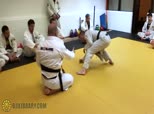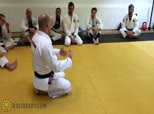Inside the University 1023 - The Finer Details of Finishing a Lapel Choke from the Back
Add to Favorites Remove From Favorites 451 1355 days ago
Gustavo goes over some intricate details of finishing the choke, including how to wrap the collar around the neck, basing on your forearm to create more pressure in the choke, and what your fingers and wrist should be doing to get the submission.
Inside the University 1022 - Collar Choke from Back Control when Your Grip Is Not Very Deep
Add to Favorites 626 Remove From Favorites 1358 days ago
In this situation, Gustavo is looking for the choke but his grip is not very deep because his opponent is defending well. So now instead of keeping his arm tight to his opponent, he extends his arms and stretches his body away to tighten the choke. After creating tension, he can close the distance to fully secure and finish the choke.Inside the University 1021 - Keeping Your Elbow Attached to His Shoulder when Choking
Add to Favorites 552 Remove From Favorites 1359 days ago
Gustavo goes over an important detail of how his elbow never loses contact with his opponent's shoulder while he is going for the choke. If it does lose connection, then his opponent will have space to escape.Inside the University 1020 - Collar Choke from the Back
Add to Favorites 512 Remove From Favorites 1360 days ago
Professor Gustavo begins class with a basic collar choke from back control. He starts with both hooks and seatbelt control, and goes over some details in maintaining a good control from here. To set up the choke, he opens the lapel and feeds it to his choking hand. His other hand makes a grip on the cross lapel and he can choke from here.Xande's Side Control Movement Patterns 16 - Escaping Mount and Back Control
Add to Favorites 585 Remove From Favorites 1361 days ago
Wrapping up the seminar, Xande ties everything together by showing how these same movement principles are used to escape the mount and back control.Xande's Side Control Movement Patterns 15 - Proper Footwork for Technical Standup
Add to Favorites 467 Remove From Favorites 1362 days ago
Xande goes over in detail the proper way to move your feet and legs when doing a technical standup, which is the movement he shows to take the mount on your opponent. His toes are pointed like a ballerina foot, and he slides his leg across the mat, as opposed to lifting it, which would create too much space.Xande's Side Control Movement Patterns 14 - Basing on Your Knee when Opponent Bumps You
Add to Favorites 592 Remove From Favorites 1365 days ago
Going into greater detail on taking the mount, Xande breaks down the motion of basing on his knee when his opponent bumps him, after Xande steps his leg over the body. His movement to mount is essentially the same as a technical standup.Xande's Side Control Movement Patterns 13 - Keeping Connection with Your Hip While Mounting
Add to Favorites 583 Remove From Favorites 1366 days ago
Covering a common mistake people make while stepping over to mount, Xande breaks down why you need to keep your hip connected to the mat while throwing your leg over. Many people tend to raise it off the ground, but this gives your opponent space to recover guard, and takes away from your base if your opponent tries to bump you off. After the foot lands, then you raise the hip as if you are standing up into base.Xande's Side Control Movement Patterns Seminar 12 - Stepping Over to Mount
Add to Favorites 635 Remove From Favorites 1367 days ago
Having secured his position up high on his opponent, Xande switches his hands so his top arm goes across the body and his bottom arm is at the him. Now using the same hip positioning principles, he switches so his hips are facing his opponent's hips instead of the head. He transitions from two to one, then steps over landing in two, and adjusts to neutral in his mount position.Xande's Side Control Movement Patterns Seminar 11 - Avoiding Rib to Rib Contact While in Side Control
Add to Favorites 684 Remove From Favorites 1368 days ago
Xande goes over an important detail of maintaining side control, which is to avoid staying with your pressure in the middle of your opponent's body with rib to rib contact. There is too much space for your opponent to escape here. Always look to have your pressure either low by his hip or high by his armpit.Xande's Side Control Movement Patterns 10 - Transitioning to a Neutral Position
Add to Favorites 633 Remove From Favorites 1369 days ago
Covering a common question, Xande goes into detail on how to transition to the neutral position, which is on the knees as most people think of side control. He does so by first transitioning from position one to position two, never losing contact between his hip and his opponent's hip. Then he can transition to neutral. The major key for him is to always keep pressure and contact on the hip and thigh while transitioning.Xande's Side Control Movement Patterns Seminar 9 - Immobilization, Transition and Aggression from Side Control
Add to Favorites 598 Remove From Favorites 1372 days ago
Xande speaks in depth on the different aspects of side control, and when and how to use it to immobilize your opponent, attack your opponent or transition to another dominant position.











